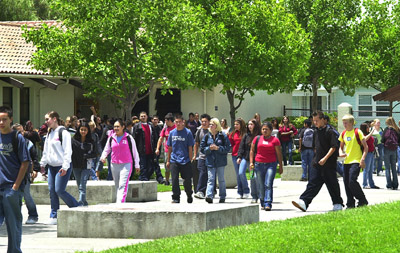Budget cuts and a shortage of teachers forced administrators at
San Benito High School to send some students letters stating there
was not enough space for everyone at summer school, leaving many
parents and students upset.
Budget cuts and a shortage of teachers forced administrators at San Benito High School to send some students letters stating there was not enough space for everyone at summer school, leaving many parents and students upset.
About 2,000 students registered for summer school classes in February, but after an intense teacher search and a reduction in summer school funding, SBHS had resources for only 1,800 students. SBHS’s school-year enrollment is about 2,700 students.
“It’s a real balancing act,” Vice Principal Duane Morgan said. SBHS’s vice principals run summer school.
Two groups of students take summer school – those in need of remedial work or low grades and those who want to allow for more electives during their regular schedule or to keep stimulated during the summer months. Students who need remediation receive first priority, Morgan said. This group makes up 90 to 95 percent of the 1,800 currently taking summer school, he said.
While remediation is important, some parents are disappointed their children did not get into summer school classes and called the admission process unfair.
“I’m upset because mine didn’t get in,” said a parent of an incoming sophomore who wished to remain anonymous. “I think (SBHS should offer) both (remediation and wanted sections), but they should at least be fair in the way they allocate their resources.”
When it came to determining which students to enroll who wanted to attend – not needed – summer school, Morgan said guidance technicians reviewed each student’s situation. Contrary to rumors, the school did not use a lottery to determine who was admitted.
“We went through each student and tried to make a good judgment on which one really needed it,” Morgan said. “There’s not a good way to do it.”
There are 45 sections offered this summer, according to the summer school program, including six sections of World Studies, four of U.S. History and economics, three sections of pre-algebra and two of biology. To fill these classes with enough teachers, administrators went beyond the school’s teaching staff and “interviewed a lot of teachers – including teachers here who are not on the regular staff,” Morgan said. Many teachers get into the profession to get summers off, Morgan said.
Also, SBHS had to deal with a reduction in state funding to pay for summer school. The state has decreased funding for students who attend summer school to get ahead in core academic classes. The state will fund 5 percent of the student population as opposed to 7 percent, Slater said. The 5 percent computes to about 135 students. For students who take classes to make up units or for remediation, the state funding is uncapped at $3.45 per student per hour, she said.
“Financially, that did impact us quite a bit,” Morgan said.
Some parents still feel the admittance policy for summer school at SBHS should be re-evaluated.
In a letter to the editor on June 18, Raye de la Vega said, that if every student can’t attend summer school, only those who need summer school should be allowed.
“If every student can not attend, summer school should be on an as-needed, teacher-recommended policy,” de la Vega said. “… changes need to be made on how students will be admitted to summer school in the future.”
The parent of the sophomore student agreed.
“If he has the inclination to do it, that should be fostered. It needs to be from both ends,” he said.










